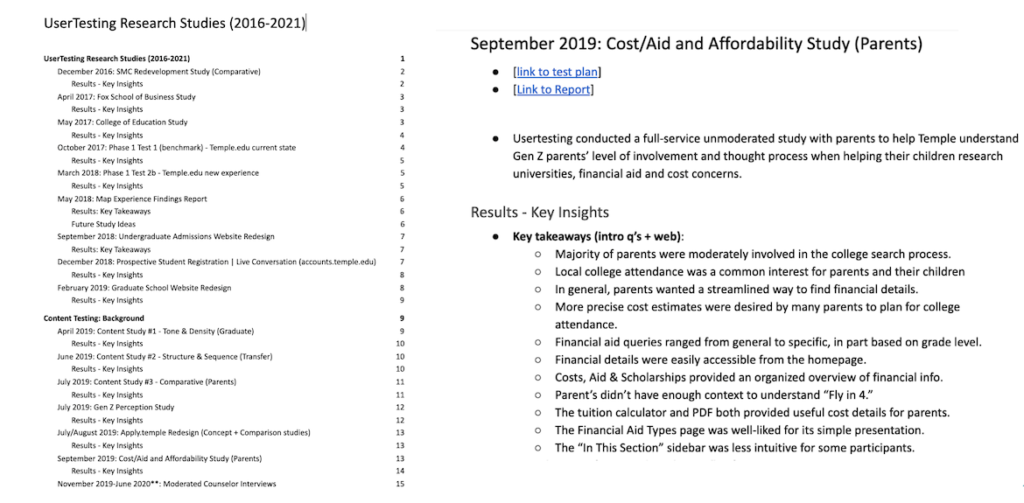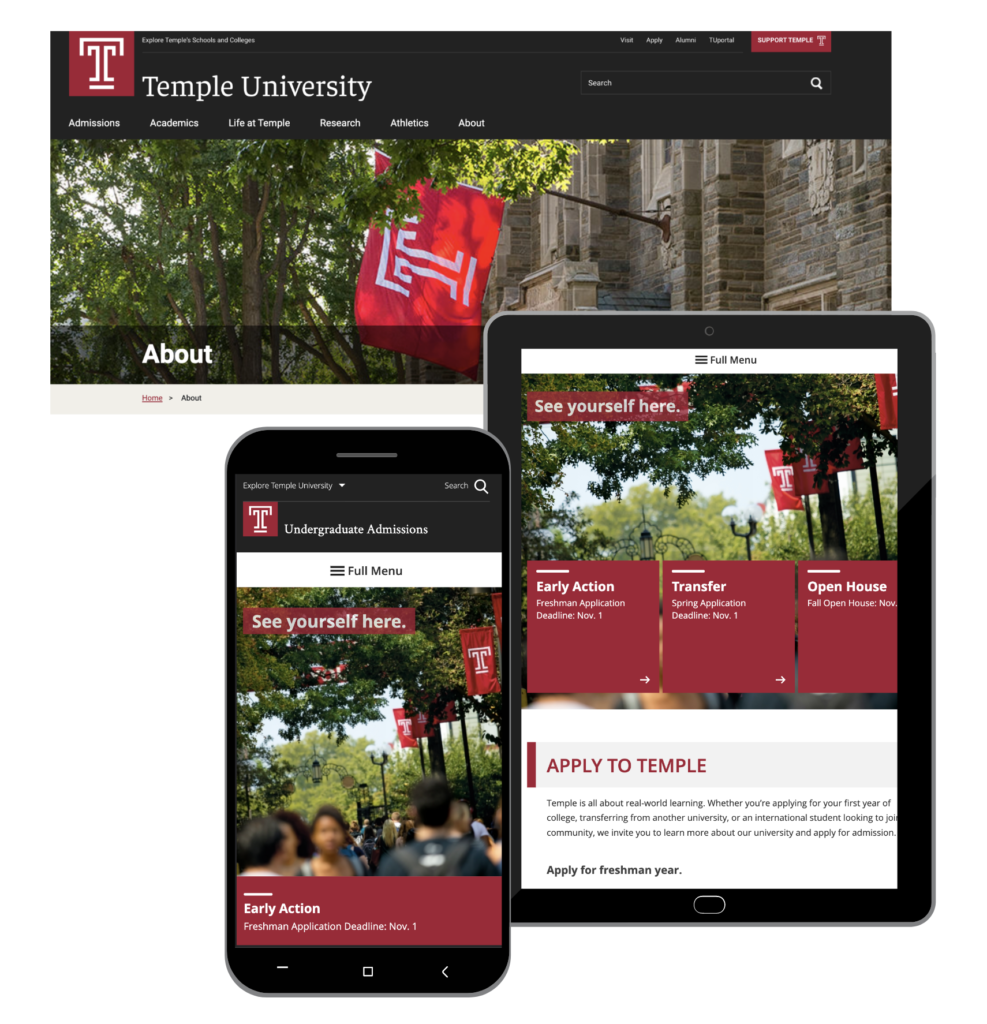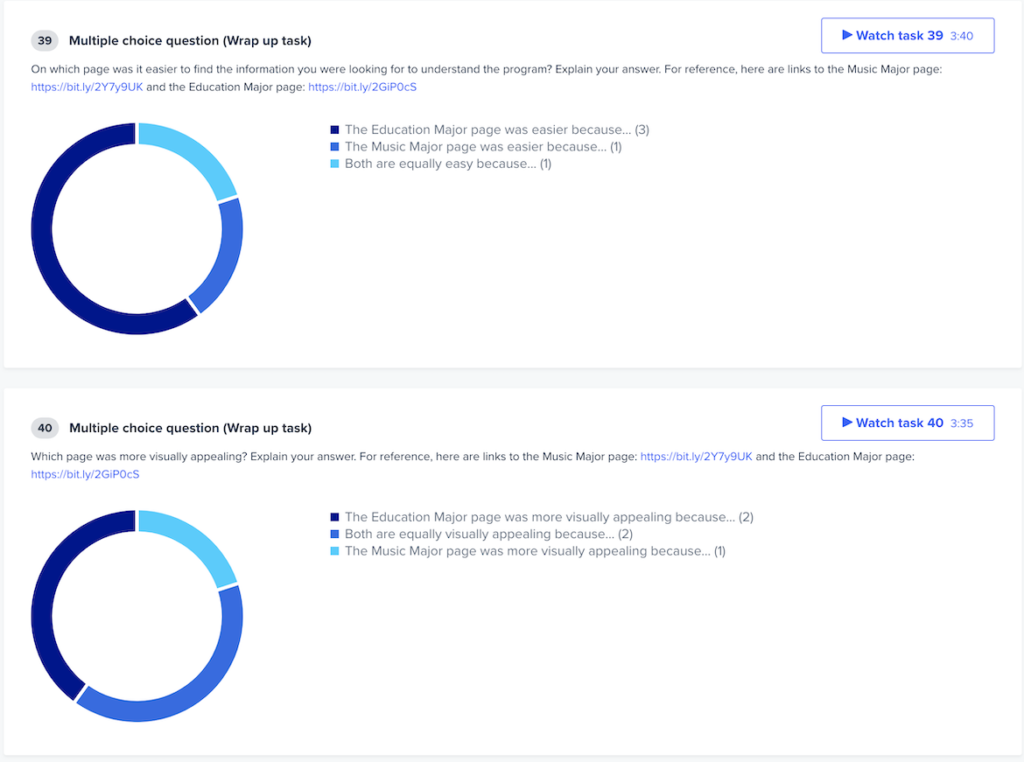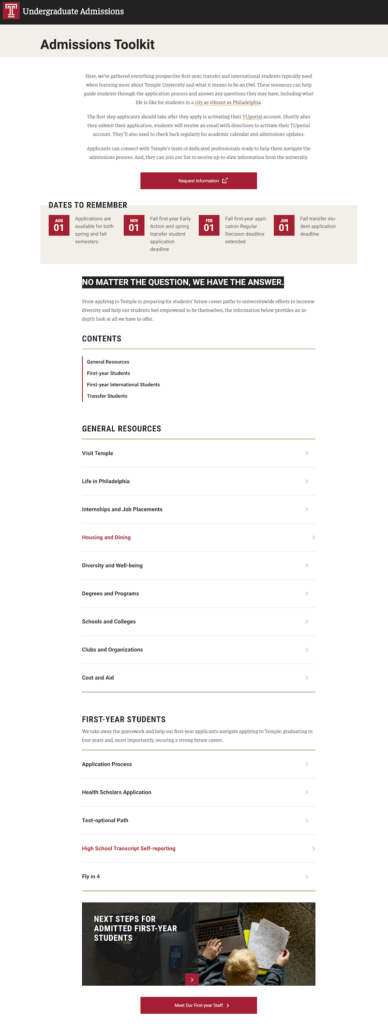As a UX researcher I try to orient myself according to principles of systems and design thinking. I listen closely to user feedback to chart a course for improvement, and to make sure what we’re making is accessible to everyone. I enjoy the process of distilling messy quantitative + qualitative findings into succinct, actionable presentations that can be used by stakeholders of varying technical backgrounds and abilities.
- Team: At Temple, our UX team included a QA manager, visual designer, data analyst and web analyst. We worked closely with the in-house development and web content teams on our research initiatives.
Research Roadmap
As Associate Director of UX, I led the process of gathering research priorities for the year ahead. I was responsible for figuring out how to service the department and overall university research needs while also taking care of our own UX/design and development team’s ongoing research questions. Experimenting with a blend of quantitative and qualitative research was a key part of this. I facilitated conversations across the department, with marketing leads who worked on brand research/development, to combine and coordinate our resources. I also helped fit these deliverables into larger strategic/business timelines with graphics like the one below.

Organization + Systems: Research Library
As I was the first person in a full-time UX research role at Temple, I had inherited an assorted mass of research that had been done over the years in the form of various documents, spreadsheets, usability studies and presentations. I worked to organize and categorize what had been done, creating a “table of contents” of research studies with key takeaways and insights for each so that everyone in the department could access the research as needed. I linked to the original study/videos for anyone who wanted to dive deeper, and socialized this resource across the department. Each time a study was done, it was added to the table of contents.
Working with UserTesting’s team + platform
As UX researcher and then Associate Director, I was responsible for managing Temple’s relationship with usertesting.com, with whom we had a long-term contract. I was lucky enough to work closely and learn from UserTesting’s staff of experienced researchers, reviewing test plans, collaborating on screeners and research questions, and benefiting from senior researchers’ advice on test design, crafting non-leading research questions and screening for targeted participants. The platform made it easy to run tests and recruit for participants quickly and gain immediate insights. Our number of participants per test hovered around 5-10, and we were able to gather and analyze behavioral data using the metrics tab.
Professional Development/Learning: Along with my team, I attended the UserTesting Conference in NYC in 2018. Companies from a wide range of industries were present, and we learned a lot about how they communicated research insights to their teams. One takeaway was that sharing user voices verbatim—video, audio or quotes—directly with stakeholders and leadership teams was one of the most simple, and effective tactics.
Usability Research
Working alongside my team and the UserTesting researchers, I led a number of research studies for Temple.
Admissions website
In order to redesign the Undergraduate Admissions website, my team applied a strategic research approach, picking out relevant existing research and supplementing it with new usability testing done through UserTesting. We used this research consistently as a team to discern the best way to display key content, and get stakeholders on board with our content and design decisions. Some of the research we gathered included:
- Baseline testing – measuring how the site was performing before the redesign
- Cost and Aid research – interviewing parents and students about the topics of tuition and financial aid
- Homepage testing – design, imagery, content, top tasks
See more details about the research I did for this site below.
Academic marketing content testing
When first on the UX team, I collaborated closely with web content team members to develop and test academic informational content that the team had written and published on temple.edu. We ran several tests, investigating questions like
- How well do users understand the content?
- What do users think about the length of the pages?
- Does the informational sequence make sense?
- What do users think about the tone of the content?
Some results from this series of studies are displayed below, with clear recommendations and roles broken out for each study.
Wayfinding Research Studies
I spearheaded multiple web navigation tests on mobile as well as desktop, including one involving a new “multisite” configuration in development.
- These studies all asked the basic question: where are the pain points in the user experience, and how can we improve them? The university’s web ecosystem is sprawling, and these studies were a great chance to identify its strengths and weaknesses.

Audience Research Presentations
One of our overarching goals as a research team was to help marketing and other university partners understand our audiences, including prospective students, transfer students, parent and family audiences, and high school counselors. Together with the director of user experience and our research analyst colleague, I helped put together decks on each audience. We subsequently presented to leadership and marketing teams. These exercises allowed me to explore and practice presentation design strategies.
High School Counselor Research
One audience we looked at in depth was high school counselors. These documents were prepared for team members working on marketing campaigns as well as university partners.
Moderated testing + Focus groups
I participated in focus groups with admissions staff members about recruiting pain points and needs. We also conducted group discussions with transfer students about their experiences during the application process and orientation. I took insights from these conversations and added them to our compilation of audience research insights.
For the counselors in particular, my team and I created a wireframe, and then this landing page assembling resources for this audience to allow them to have the essential links for recruiting conversations at their fingertips.




